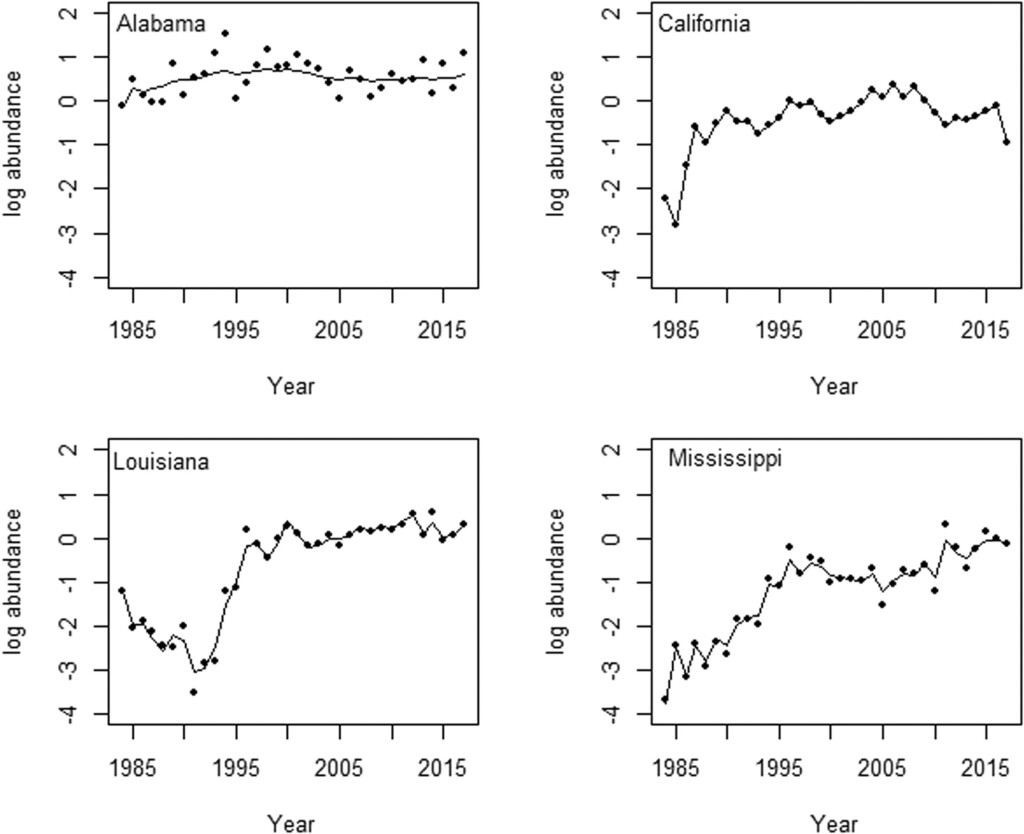
LINKED PAPER
Assessing long-term dynamics of non-breeding Brown Pelican (Pelecanus occidentalis) populations using Christmas Bird Count data. Evans, K. O., Davis, J. B., & Wang, G. 2023. IBIS. DOI: 10.1111/ibi.13105. VIEW
The Brown Pelican (Pelecanus occidentalis) experienced a dramatic decline during the mid-20th century. The use of organochlorine pesticides, such as DDT, pushed this seabird to the brink of extinction (King et al. 1977). Luckily, conservation efforts – including the translocation of young birds – reversed the downward trend and helped the Brown Pelican to make a remarkable comeback (Holm Jr. et al. 2003). However, different populations showed variation in their recovery rates. Understanding the underlying factors that sped up or slowed down these recovery rates can help conservationists to implement even better management strategies in the future.
Christmas Bird Count
Kristine Evans and her colleagues used 34 years of data from the Audubon Christmas Bird Count (1984-2017) to assess the population dynamics of Brown Pelicans. They focused on populations in four US states: Alabama, California, Louisiana and Mississippi. Statistical models revealed that the Alabama population has been stable over time, whereas the other three populations followed a fluctuating trajectory. The populations in California, Louisiana and Mississippi expanded during the 1980s, stabilized throughout the 1990s, and increased again from the 2000s until the present day. These patterns confirmed earlier studies on particular populations (Anderson et al. 2013, Holm Jr. et al. 2003, Selman et al. 2016).

Figure 1. Population trajectories of Brown Pelicans derived from Christmas Bird Count data in Alabama, California, Louisiana and Mississippi, 1984–2017. Lines are model predictions; black dots are observations.
Intraspecific Competition
But which factors can explain these population trajectories? Most populations seem to have experienced direct negative effects due to high numbers of pelicans competing for food sources and roosting sites (i.e. density-dependent factors). Brown Pelicans forage close to their breeding grounds, resulting in fierce competition for fish among members of the same colony (Geary et al. 2018). In addition to foraging patches, the pelicans compete for nearby roosting sites where they can rest, exchange social information and avoid predators or adverse weather conditions (Walter et al. 2013). These findings highlight the importance of sufficient foraging and roosting sites to ensure a bright future for the Brown Pelican.
References
Anderson, D.W., Henny, C.J., Godínez-Reyes, C., Gress, F., Palacios, E.L., Santos Del Prado, K., Galloreynoso, J.P. & Bredy, J. (2013). Size and distribution of the California Brown Pelican metapopulation in a non-ENSO year. Marine Ornithology 41: 95–106. VIEW
Geary, B., Walter, S.T., Leberg, P.L. & Karubian, J. (2018). Condition-dependent foraging strategies in a coastal seabird: evidence for the rich get richer hypothesis. Behavioral Ecology 30: 356–363. VIEW
Holm, G.O. Jr., Hess, T.J. Jr., Justic, D., McNease, L., Linscombe, R.G. & Nesbitt, S.A. (2003). Population recovery of the eastern Brown Pelican following its extirpation in Louisiana. The Wilson Bulletin 115: 431–437. VIEW
King, K.A., Flickinger, E.L. & Hildebrand, H.H. (1977). The decline of Brown Pelicans on the Louisiana and Texas Gulf Coast. The Southwestern Naturalist 21: 417–431. VIEW
Selman, W., Hess, T.J. & Linscombe, J. (2016). Long-term population and colony dynamics of brown pelicans (Pelecanus occidentalis) in rapidly changing coastal Louisiana, USA. Waterbirds 39: 45–57. VIEW
Walter, S.T., Carloss, M.R., Hess, T.J., Athrey, G. & Leberg, P.L. (2013). Movement patterns and population structure of the brown pelican. The Condor 115: 788–799. VIEW
Image credits
Top right: Brown Pelican (Pelecanus occidentalis) | Frank Schulenburg | CC BY-SA 4.0 Wikimedia Commons
Blog posts express the views of the individual author(s) and not those of the BOU.
If you want to write about your research in #theBOUblog, then please see here





